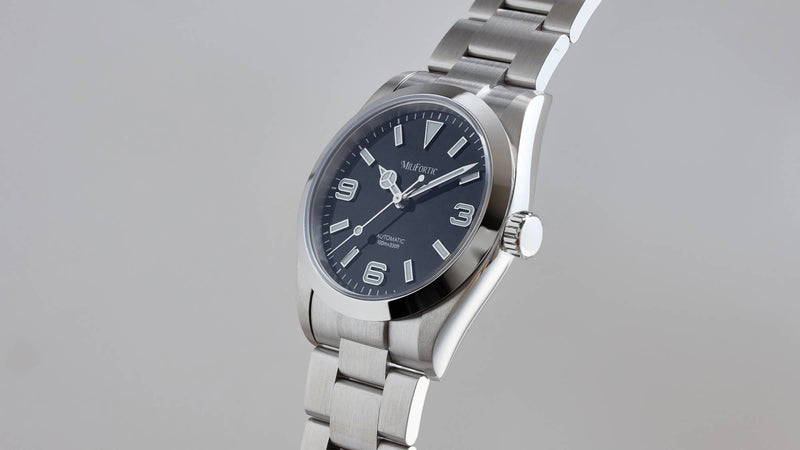
Table of Contents
- The Three Types of Watches That Truly Don’t Require Batteries
- Common Misconceptions: Kinetic and Solar Watches Do Have Batteries
- Advantages of Watches That Don’t Require Batteries
- Disadvantages of Watches That Don’t Require Batteries
- Five Recommended Entry-Level Watches That Don’t Need Batteries
- Conclusion
If you’re new to the world of timepieces, you might assume every watch relies on a battery to power its movement. However, there are certain watches that don’t require batteries at all—thanks to clever mechanical engineering. Below, we’ll explore the three main types of battery-free watches, dispel some common misconceptions, and discuss both the advantages and disadvantages of these timeless pieces. Finally, we’ll offer five recommendations for entry-level models to help you start your journey into watches.
Please note: References to batteries in this article include secondary batteries or capacitors with a similar function to batteries.
Here is a simple example diagram showing non-battery-powered watches and that can easily be mistaken for a battery-powered watches:
The Three Types of Watches That Truly Don’t Require Batteries
1. Automatic Mechanical Watches
Automatic mechanical watches contain a rotor (often called a “winding rotor” or “oscillating weight”) that spins on a pivot with the natural motion of the wearer’s wrist. As the rotor turns, it winds the watch’s mainspring, storing energy to power the movement. Whether worn on the wrist or carried in a pocket (for pocket watches), the daily motion of the watch ensures consistent winding—so it keeps running without the need for an external battery.
Key Points:
- Energy source: Motion of the wrist
- Contains a rotor connected to a winding mechanism
- Requires regular wear (or occasional manual winding if not worn for a while)
2. Manual Wind Mechanical Watches
In a manual (hand-wound) watch, the wearer must turn the watch’s crown periodically, which tightens the mainspring and stores potential energy. This stored energy powers the gear train and keeps the watch running. While manual winding might seem old-fashioned, many collectors find it satisfying and enjoy the ritual of winding their watch each day.
Key Points:
- Energy source: Hand-winding using the crown
- The mainspring powers the watch until it needs rewinding
- Offers a traditional, hands-on experience valued by watch enthusiasts
3. Seiko Spring Drive

The Seiko Spring Drive is a unique technology developed by Yoshikazu Akahane and his team at Seiko. While it relies on a mainspring like a traditional mechanical watch, it also integrates an electronic regulator to achieve remarkable accuracy. Essentially, the Spring Drive uses the mechanical energy from the mainspring to drive the gears, but instead of a traditional escapement, it employs a “Tri-synchro regulator” that uses electromagnetic power to control the speed of the glide wheel. This combination of mechanical and electromagnetic regulation means there’s no separate battery involved—just the continuous energy from the spring that’s precisely controlled for highly accurate timekeeping.
Key Points:
- Hybrid system: mechanical mainspring + electronic regulator
- Ultra-smooth sweeping second hand and high accuracy
- No conventional battery; power is purely mechanical, regulated electronically
Common Misconceptions: Kinetic and Solar Watches Do Have Batteries
1. Kinetic Watches

Some watches, such as Seiko’s Kinetic line, convert the wearer’s motion into electrical energy, which is stored in a rechargeable capacitor (sometimes referred to as a “secondary battery”). While this may not look like the small button cells found in traditional quartz watches, it still functions as a type of battery. Strictly speaking, a kinetic watch is not entirely mechanical because it relies on an electronic circuit powered by the stored electrical energy.
How Kinetic Works:
- User motion powers a small generator inside the watch
- The generated electricity is stored in a rechargeable capacitor
- This powers a quartz movement that keeps time
2. Solar Watches (e.g., Citizen Eco-Drive)

Solar-powered watches also store energy in rechargeable batteries (often called “secondary batteries” or capacitor). Citizen’s Eco-Drive is a prime example, where the watch dial typically contains solar cells that convert light into electrical energy. Although these timepieces are marketed for their eco-friendliness and longevity, they still rely on a battery to store the converted solar power.
How Solar Works:
- Light (natural or artificial) is absorbed by solar cells on the dial
- Electricity is generated and stored in a small rechargeable battery
- A quartz movement draws power from that stored energy
Advantages of Watches That Don’t Require Batteries
Eco-Friendly
Without the need for battery replacements or recharge cycles, purely mechanical watches have minimal environmental impact over their lifespan.
Artistic Mechanical Structure
Mechanical movements often showcase the intricate interplay of gears, springs, and rotors. Collectors and enthusiasts love being able to see (and sometimes hear) the craftsmanship that goes into a mechanical timepiece. For those who value tradition, history, and engineering, mechanical is the ultimate expression of horological art.
Complex Mechanical Functions
Many complicated watch functions—such as tourbillons, perpetual calendars, and minute repeaters—are feats of mechanical ingenuity. These functions highlight human craftsmanship and innovation without relying on electronics or batteries.
Disadvantages of Watches That Don’t Require Batteries
-
Less Accurate than Quartz
Mechanical watches, on average, are not as precise as quartz watches. While high-end mechanical movements can be very accurate, they still can’t match the pinpoint consistency of quartz technology. -
Higher Maintenance Costs
Mechanical watches contain countless tiny, precise components. Every 3–5 years, they require a comprehensive service (cleaning, oiling, recalibration) to ensure accurate timekeeping, which can be more costly compared to replacing a quartz battery. -
Higher Initial Price
Mechanically powered watches tend to be more expensive due to the craftsmanship, materials, and labor involved in producing their intricate movements. Compared to mass-produced quartz watches, you’re often paying for artisanal skill and mechanical complexity.
Five Recommended Entry-Level Watches That Don’t Need Batteries
1. Seiko 5 Automatic
Affordable, robust, and beloved by watch enthusiasts worldwide. The Seiko 5 line is known for its reliable automatic movement and iconic design.
2. Orient Bambino
Famous for its classic design and domed crystal, the Bambino is an elegant automatic dress watch with great value for its price.
3. Hamilton Khaki Field Mechanical
A hand-wound military-inspired watch that combines historical charm with modern reliability. Perfect for those who enjoy daily winding.
4. Tissot Everytime Swissmatic
An accessible Swiss automatic with a clean, minimalist dial—ideal for anyone seeking Swiss craftsmanship without the hefty price tag.
5. Milifortic S093
The milifortic S093 pays tribute to the Rolex Explorer with a brushed case, 3D markers, BGW9 lume, and outstanding value.
Conclusion
Watches that don’t need batteries embody a captivating blend of art, history, and engineering. Whether you choose an automatic, manual wind, or the innovative Seiko Spring Drive, you’ll experience the charm of mechanical timekeeping firsthand. These pieces do require a bit more care and cost than their quartz counterparts, but for many enthusiasts, the emotional connection and storied craftsmanship they offer are well worth the investment.
If you’re considering venturing into the world of battery-free horology, start with an entry-level model to familiarize yourself with winding techniques and maintenance schedules. In the process, you’ll discover why, for over a century, people have treasured the heartbeat of a mechanical watch on their wrists—an enduring emblem of fine craftsmanship that keeps on ticking, all without a battery.



So tired of replacing watches or going to find places that replace watch batteries. Want a watch like I had as a kid which I wound.